Published
on 2
Feb 2025
|
All rights reserved.
|
|
|
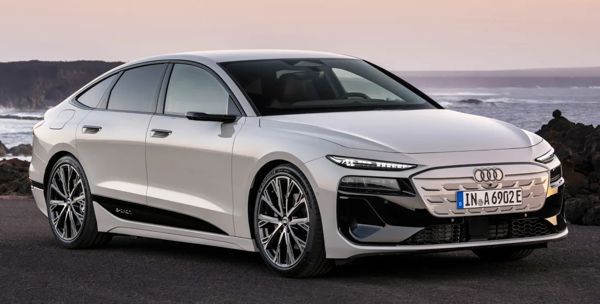
|
|
A6
reinvented as an electric car.
|
|
In
the transition from combustion to electric power, Audi adopts an
interim solution: electric cars and combustion cars will co-exist for a
generation, the former taking the original nameplates like A4 and A6,
while combustion alternatives taking A5 and A7. (Amendment on Feb 4: just one day after
this article has been published, Audi shocked the world by announcing
U-turn on the new naming strategy as dealers expressed concerns about
confusion. The upcoming combustion version will
be called A6 TFSI or A6 TDI instead of A7, while electric version can
be distinguished by "e-tron". However, A4 and A5 will keep
going as planned.) Unlike the flexible
power approach of BMW’s CLAR platform, Audi opts for completely
different platforms. The combustion cars use Premium Platform
Combustion (PPC) which is actually a lightly updated version of the
outgoing MLB Evo platform, while electric cars get a brand-new
skateboard platform called Premium Platform Electric (PPE) which is
shared with Audi Q6 E-tron and Porsche Macan. It runs 800V electrical
system, so you can expect higher energy efficiency and faster charging
than the 400V systems currently employed by BMW and Mercedes, although
the upcoming Neue Klasse and CLA will switch to 800V as well.
As it is an all-new platform co-developed with Porsche, we expect
sports car like proportion. Somehow, the A6’s packaging is not
particularly good. Technical drawings show the battery pack, which
fills fully between axles, is quite thick. The A6 is actually the same
height as its combustion predecessor, but this is achieved by using a
shallower greenhouse. The waistline is set high, so is the bonnet,
making the body looks thick and the car bulky. To make matters worse,
Audi places its sealed version of single-frame grille higher at the
nose, below which is a messy combination of lights, intake grilles and
gloss black panels. I don’t understand why it cannot make the
proportion nicer to eyes. Considering electric motors are more compact
than engines, it could have lowered the bonnet easily. The waistline
could cut deeper into the doors so that windows can be enlarged. Had
Audi done in that way, the A6 could have looked much healthier in
proportion. Tesla and Lucid managed to do so, why not European
manufacturers?
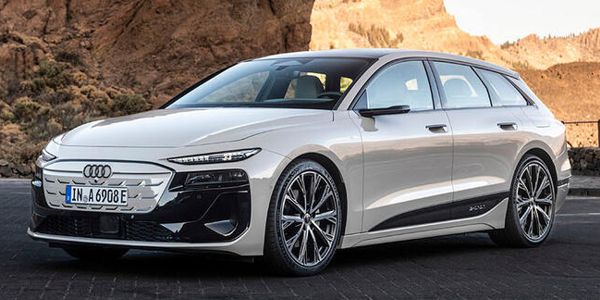 |
|
Low
drag contributes to remarkable efficiency and range.
|
|
Apart from switching to
full-electric, the new A6 is also converted into a fastback, or in
Audi's language, Sportback. There might be two reasons for the change:
Firstly, as an electric car it needs a sleeker shape to achieve lower
drag hence longer range. In fastback form, the A6 has a very low Cd of
0.21 (though you need the optional rearview door cameras to achieve).
Avant is also very good at 0.24. Secondly, the presence of rear-drive
motor means the boot will be inevitably shallower. A fastback allows
stacking luggage up to the roof thus is more accommodating. In this
case, its 502 liters boot is competitive enough. Unfortunately, the
Avant’s luggage space is exactly the same as the sedan, which is small
for a wagon.
Open the doors, you will see the rear seat is mounted close to the
cabin floor, so passengers will need to have their legs raised, and
there is precious little foot space left under the front seats. Rear
headroom is not much better, compromised by the sloping roofline. Not
exactly a disaster, but certainly not something a luxury car deserves.
This means Avant is a better bet.
Most of the dashboard is shared with the latest A5, especially the
curved display combining an 11.9-in instrument and 14.5-in touchscreen,
both are OLED thus show bright and crisped graphics. Though still
called “Virtual Cockpit”, the new instrument is not quite as
configurable as the old one, which could display navigation map at the
background. The touchscreen infotainment system gets improved user
interface, but it is no replacement for physical switches. A rotary
knob is kept for adjusting audio volume, but climate control and
driving aids must go through the touchscreen, which is not handy enough
when you are driving. Moreover, the haptic touch-sensitive buttons on
steering wheel are prone to be activated accidentally.
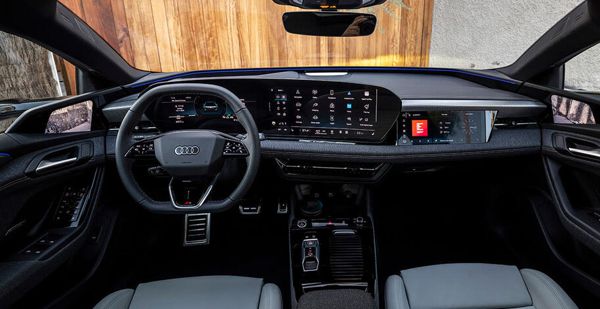
|
|
Rear
seat comfort is compromised by high floor and sloping roofline. |
|
Build quality and material choices of the cabin seem to be adequate,
especially fabrics made from recycled plastics. However, at the door
panels and lower down the dashboard you can find plenty of hard
plastics, which do no justice to the car’s premium prices from
£64,000 to £84,000, or even £100K for S6. The gloss
black plastics on center console look a bit cheap, too. On the plus
side, the optional panoramic glass roof can lift the premium feel. Its
transparency level is adjustable, not just as a whole but can be
individually for front and rear rows. It also helps relieving the
claustrophobic feel at the rear bench.
Compared with its flawed styling and packaging, the technical side of
the new A6 is a lot better – after all, the PPE platform is
co-developed with Porsche. No longer compromised by the Quattro layout,
the electric Audi can utilize rear-wheel drive for single-motor version
and achieve 48:52 weight distribution – very un-Audi, isn’t it?
Base model offers 286 horsepower, or briefly boosted to 326 hp in
launch mode, good for 0-60 mph in 5.7 seconds. Its 83 kWh battery pack
achieves a WLTP range of 624 km (388 miles), showing impressive
efficiency.
All other models employ 100kWh pack for even longer range. A6
Performance uses a larger motor to offer 367 hp (or 381 hp in launch
mode), achieving 0-60 mph in just over 5 seconds and 753 km (468 miles)
of range. A6 Quattro adds another motor at the front axle, boosting
horsepower to 428 hp (or 462 hp in launch mode) and cutting 0-60 to 4.3
seconds, but reduces range slightly to 714 km (444 miles). All are
massively more efficient than the BMW i5 and Mercedes EQE. While its
performance is not particularly strong for an EV, the Audi’s strongest
selling point must be its outstanding range and efficiency. Charging is
also pretty quick at 270kW, taking 21 minutes to go from 10-80 percent
for the larger battery.
The car rides on 5-link suspensions front and rear. Like its
predecessor, adaptive air springs can be added, otherwise it relies on
passive frequency selective dampers. Rear-wheel steering is not offered
this time around, perhaps because the car is better balance enough.
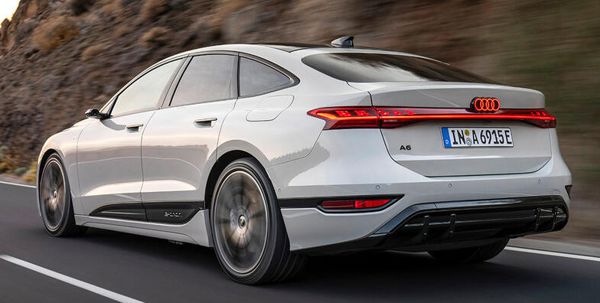
|
|
Not
particularly quick, but chassis delivers decent handling and impressive
refinement.
|
|
On the road, the A6 Performance or Quattro feels quick enough. Power
delivery is predictably responsive, but more important is smooth and
linear. Cruising refinement is impressive, thanks to the quiet
powertrain, lack of wind and road noises. If you opt for air
suspension, the ride is smooth, too, even on the largest 21-inch wheels
for S-line trim. Likewise, the brake pedal is expertly calibrated,
blending regenerative and mechanical braking seamlessly. You may adjust
the level of regenerative braking among different settings or using
paddles.
The air suspension also lends the A6 good body control. The Michelin
Pilot Sport EV tires offer decent grip considering they are low rolling
resistance rubbers. However, the A6 still lacks the driver appeal of
BMW i5, let alone a Porsche Taycan or Audi’s own E-tron GT. Its
steering is precise but short of communication, a typical Audi problem.
While the A6 balances well in normal driving, push harder and you will
be reminded of its 2.2 tons weight as the car understeers. Its balance
is probably less adjustable than the BMW, although the difference is
smaller than ever before. Overall, the A6’s chassis seems well
polished, delivering superb refinement and decent handling.
In addition to the excellent efficiency and driving range as well as
quick charging, it sounds every bit the ideal electric car Audi aims to
build. What a pity the styling is so uninspiring, rear seat comfort is
compromised and the user interface flawed. Don’t know why when Audi has
sorted problems out, some new problems must arise. When can it put all
things together correctly and end up as a winner?
|
Verdict:     |
Published
on 2
Feb 2025
|
All rights reserved.
|
|
Audi S6 e-tron
|
|
 |
|
New
S6 is a well judged balance between comfort and performance.
|
|
The S6 has always been the
first level of performance upgrade from the A6. Throughout its colorful
life, it adopted different kinds of powertrain: V8, V10, twin-turbo V8,
twin-turbo and electric-charged V6 or even V6 turbo diesel. Writing
about the S6’s engines has always been a joy to me. Unfortunately,
entering the electric era, this is no longer the case. No matter the
regular A6 Quattro, S6 or the upcoming RS6, they employ 2 electric
motors, one at each axle. Their motors might be different in small
details, but you won’t care. What you care about is the outcome: it
offers 503 horsepower and 630 pound-foot of torque. This can be lifted
briefly to 551 horsepower in launch mode, which enables a
headline-grabbing 0-60 mph time of 3.8 seconds. That’s half a second
quicker than the A6 Quattro or 0.6 second less than the last generation
S6 with petrol engine. Top speed is 149 mph though, down from the usual
155 mph.
However, compared with its electric rivals, the S6 is slightly slower.
BMW i5 M60 is good for 0-60 mph in 3.7 seconds. Mercedes-AMG EQE53 and
Porsche Taycan GTS achieve the same benchmark in merely 3.2 seconds,
while Tesla Model S dual-motor is even quicker at 3.1 seconds. It lacks
the explosive sensation of its rivals under full bore acceleration,
partly due to also its well isolated cabin. On the flipside, the Audi’s
throttle response is smooth and linear. The brake pedal, too, giving it
an easy-going and confidence inspiring manner to lean on.
Apart from electric powertrain, modifications to the S6 include retuned
steering, bigger brakes, thicker anti-roll bars and standard fitment of
adaptive air springs. The latter is important to keep body movement
tidy and ride compliant in softer modes.
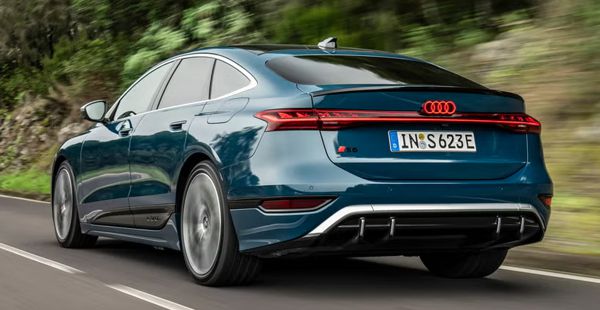 |
|
The
chassis feels well balanced, thanks to 50:50 weight distribution and 2
motors.
|
|
On the road, the S6’s dual motor Quattro system and Michelin Pilot
Sport EV tires offer plenty of grip. The chassis feels well balanced,
thanks not only to 50:50 weight distribution but also the ability to
alter power at both axles precisely. In normal driving most power is
sent to the rear wheels. As you press on in a corner, you can feel
power shifts towards the front, helps pulling the car out of corner.
The steering is precise and a little heavier than on lesser A6, which
is exactly what you want. It lacks tactile feedback, but the weight and
response feel reassuring. Ultimately, it cannot beat the laws of
physics, as the 2325kg kerb weight translates to understeer, and its
brakes start going soft after repeated abuse.
As the S6 is not RS6, it is understandable that its firepower is
deliberately restricted and its handling is not tuned to be sharper
still. This let Audi to keep its comfort and refinement from the lesser
A6s with very little to sacrifice. You may praise that a well-judged
balance.
However, keen drivers will definitely opt for Porsche Taycan for its
superior handling and communication, especially when the GTS is almost
the same price yet offers comparable range (630km, versus the Audi’s
662km) and the same 270kW charging speed. The Taycan’s cabin is not as
spacious as the S6, off course, but at least its rear passengers can
place their feet naturally into a deep footwell and under the front
seats, something the S6 fails to do.
|
Verdict:     |
|